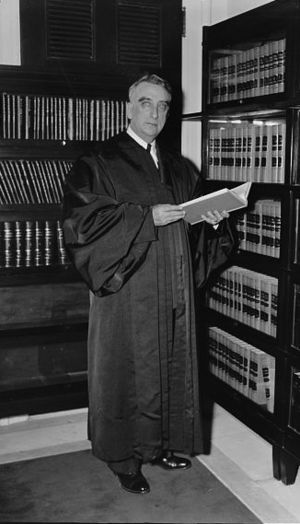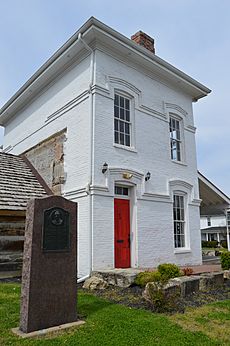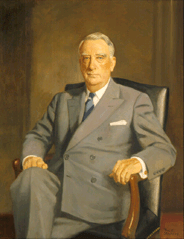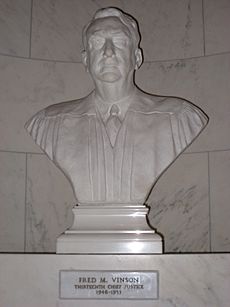Fred M. Vinson facts for kids
Quick facts for kids
Fred M. Vinson
|
|
|---|---|

Vinson in 1938
|
|
| 13th Chief Justice of the United States | |
| In office June 24, 1946 – September 8, 1953 |
|
| Nominated by | Harry S. Truman |
| Preceded by | Harlan F. Stone |
| Succeeded by | Earl Warren |
| 53rd United States Secretary of the Treasury | |
| In office July 23, 1945 – June 23, 1946 |
|
| President | Harry S. Truman |
| Preceded by | Henry Morgenthau Jr. |
| Succeeded by | John Wesley Snyder |
| Director of the Office of Economic Stabilization | |
| In office May 28, 1943 – July 23, 1945 |
|
| President | Franklin D. Roosevelt |
| Preceded by | James F. Byrnes |
| Succeeded by | William Hammatt Davis |
| Judge of the United States Court of Appeals for the District of Columbia Circuit | |
| In office December 15, 1937 – May 28, 1943 |
|
| Nominated by | Franklin D. Roosevelt |
| Preceded by | Charles Henry Robb |
| Succeeded by | Wilbur Kingsbury Miller |
| Member of the U.S. House of Representatives from Kentucky |
|
| In office January 24, 1924 – March 3, 1929 |
|
| Preceded by | William J. Fields |
| Succeeded by | Elva R. Kendall |
| Constituency | 9th district |
| In office March 4, 1931 – May 27, 1938 |
|
| Preceded by | Elva R. Kendall |
| Succeeded by | Joe B. Bates |
| Constituency | 9th district (1931–33) 8th district (1933–38) |
| Personal details | |
| Born |
Frederick Moore Vinson
January 22, 1890 Louisa, Kentucky, U.S. |
| Died | September 8, 1953 (aged 63) Washington, D.C., U.S. |
| Resting place | Pinehill Cemetery, Louisa, Kentucky, U.S. |
| Political party | Democratic |
| Spouse |
Julia Dixon
(m. 1924) |
| Children | 2 |
| Education | Centre College (BA, LLB) |
Frederick "Fred" Moore Vinson (born January 22, 1890 – died September 8, 1953) was an American lawyer and politician. He served as the 13th Chief Justice of the United States from 1946 until his death in 1953. Fred Vinson was special because he was one of the few Americans to work in all three parts of the U.S. government: the legislative (Congress), the judicial (judge), and the executive (Cabinet Secretary).
Before becoming Chief Justice, Vinson was a U.S. Representative for Kentucky from 1924 to 1928 and again from 1930 to 1938. He also served as a federal judge on the United States Court of Appeals for the District of Columbia Circuit from 1938 to 1943. Later, he was the United States Secretary of the Treasury from 1945 to 1946.
Born in Louisa, Kentucky, Vinson studied law and served in the United States Army during World War I. After the war, he became a prosecutor in Kentucky. He was elected to the U.S. House of Representatives in 1924. He lost his seat once but won it back in 1930. While in Congress, he became a close friend and advisor to Senator Harry S. Truman.
In 1937, President Franklin D. Roosevelt made Vinson a judge. Vinson left the court in 1943 to lead the Office of Economic Stabilization. When Harry S. Truman became president in 1945, he appointed Vinson as Secretary of the Treasury. In this role, Vinson helped manage the economy after World War II. He also helped set up important global groups like the International Bank for Reconstruction and Development and the International Monetary Fund.
After Chief Justice Harlan F. Stone passed away in 1946, President Truman chose Vinson to lead the Supreme Court. As Chief Justice, Vinson dealt with important cases, including one about steel mills during a strike. He also ordered a new hearing for the Briggs v. Elliott case, which later became part of the famous Brown v. Board of Education case about school segregation.
Fred Vinson is the last Chief Justice to be appointed by a Democratic president.
Contents
Early Life and Education

Fred Vinson was born in Louisa, Kentucky. His father was the jailer for Lawrence County, and Fred grew up in a house right in front of the county jail. As a child, he often helped his father at the jail. He even made friends with some of the prisoners, who remembered his kindness when he later ran for public office.
Vinson worked different jobs while he was in school. He finished Kentucky Normal School in 1909. Then he went to Centre College, where he was a top student and earned a Bachelor of Arts degree. He also got a law degree from the College of Law. After finishing his studies, he started his own law practice in Louisa. His first elected job was as the City Attorney for Louisa.
During World War I, Vinson joined the Army. After the war, he was elected as the prosecutor for Kentucky's Thirty-Second Judicial District. Fred Vinson married Julia Roberta Dixon on January 24, 1924. They had two sons together.
Serving in Congress
In 1924, Vinson ran for a special election to represent his district in Congress. The previous representative, William J. Fields, had resigned to become the Governor of Kentucky. Vinson, a Democrat, won the election. He was reelected twice but lost his seat in 1928. Many believed he lost because he supported Al Smith's presidential campaign, which was unpopular in his area.
However, Vinson ran again in 1930 and won back his seat. He served in Congress until 1937. During this time, he became good friends with Senator Harry S. Truman from Missouri. This friendship lasted their whole lives. Vinson became a trusted advisor and friend to Truman.
In 1930, Vinson moved his law practice to Ashland, Kentucky. He wanted to return to Washington, D.C., as a congressman. He built a group of friends in Ashland who could help him in politics. Vinson returned to Congress in 1931 and strongly supported President Roosevelt's "New Deal" programs, which aimed to help the country recover from the Great Depression.
A Judge on the U.S. Court of Appeals
President Franklin D. Roosevelt nominated Fred Vinson to be a judge on the United States Court of Appeals for the District of Columbia Circuit on November 26, 1937. The United States Senate approved his nomination on December 9, and he officially became a judge a few days later. He also served as the Chief Judge of the Emergency Court of Appeals. Vinson left this judicial role on May 28, 1943.
Secretary of the Treasury


Vinson resigned from his judge position to become the Director of the Office of Economic Stabilization. This government agency was responsible for fighting inflation, which is when prices go up too much. He also worked as the Federal Loan Administrator and director of War Mobilization and Reconversion.
On July 23, 1945, President Truman appointed Vinson as the United States Secretary of the Treasury. He served in this role until June 23, 1946. His main job was to help the American economy become stable during the final months of World War II and to prepare the country's finances for the time after the war. Before the war ended, Vinson led the last major drives to sell war bonds.
After the war, Vinson helped arrange the payment of the Anglo-American loan to Britain. This was the largest loan the United States had ever given to another country ($3.75 billion). He also managed the agreements for "Lend-Lease" aid, which was economic and military help given to allies during the war. To encourage businesses to invest in America after the war, he supported a tax cut in 1945.
Vinson also oversaw the start of two important international organizations: the International Bank for Reconstruction and Development and the International Monetary Fund. Both of these were created at the Bretton Woods Conference in 1944. Vinson was the first chairman of their boards. In 1946, Vinson left the Treasury Department to become the Chief Justice of the United States.
Leading the Supreme Court
President Harry S. Truman nominated Fred Vinson to be the Chief Justice of the United States on June 6, 1946, after the death of Chief Justice Harlan F. Stone. Former Chief Justice Charles Evans Hughes and former Justice Owen Roberts both recommended Vinson to Truman. They pointed out that Vinson had experience in all three branches of the federal government. The United States Senate approved Vinson's nomination on June 20, 1946. He took his oath of office on June 24.
When Vinson became Chief Justice, the Supreme Court was having some disagreements among its members. Vinson was praised for helping to bring the justices closer together. He served as the presiding officer for important judicial conferences from 1946 to 1953. He also served as a Circuit Justice for the Fourth Circuit and the District of Columbia Circuit. His time as Chief Justice ended when he passed away on September 8, 1953.
During his time on the Supreme Court, Fred Vinson wrote 77 opinions for the court and 13 dissenting opinions (where he disagreed with the majority). One of his most notable dissents was in a case where the court ruled against President Truman's decision to take control of the nation's steel mills during a strike in 1952. This case was called Youngstown Sheet & Tube Co. v. Sawyer.
Vinson's court dealt with major issues like racial segregation, labor unions, and communism. Regarding racial segregation, he wrote that states using the "separate but equal" rule had to provide facilities that were truly equal. He wrote this in cases like Sweatt v. Painter and McLaurin v. Oklahoma State Regents. The important case of Briggs v. Elliott was before the Court when he died. Vinson wanted a unanimous decision, so he ordered a second hearing for the case. He passed away before the case could be heard again. After his death, Earl Warren was appointed Chief Justice, and the case was heard again as part of Brown v. Board of Education, which famously ruled against school segregation.
As Chief Justice, Fred Vinson swore in both Harry S. Truman and Dwight D. Eisenhower as President of the United States.
Death and Legacy
Fred Vinson died on September 8, 1953, from a heart attack at his home in Washington, D.C. He was buried in Pinehill Cemetery in Louisa, Kentucky.
A large collection of Vinson's personal and legal papers is kept at the University of Kentucky in Lexington, Kentucky. These papers are available for people to research his life and work.
At Centre College, where Vinson studied, there is a portrait of him in the Phi Delta Theta fraternity house. Vinson was a member of this fraternity. The portrait is affectionately known as "Dead Fred" and is sometimes taken by fraternity members to football games and other events.
Vinson's birthplace in Louisa, Kentucky, is listed on the National Register of Historic Places, recognizing its historical importance.
Images for kids





